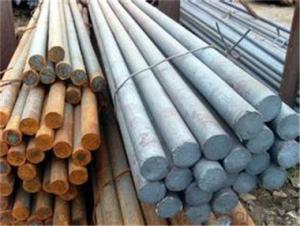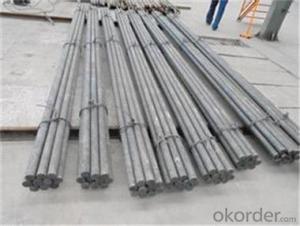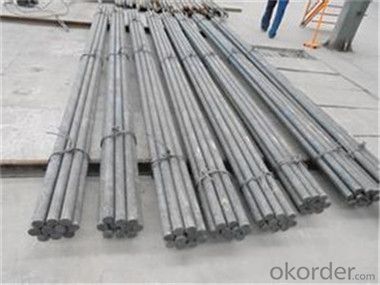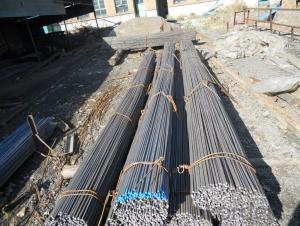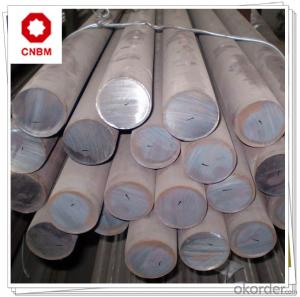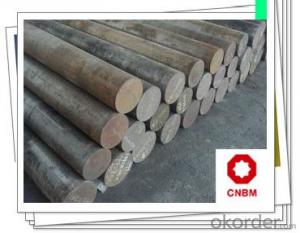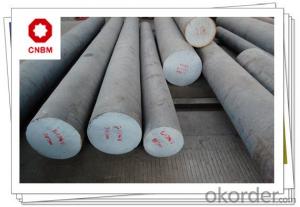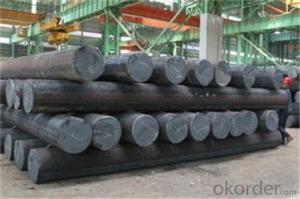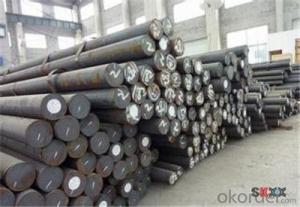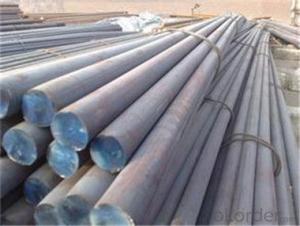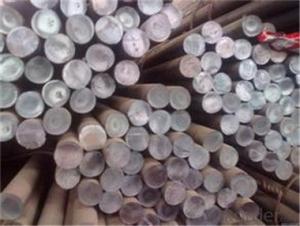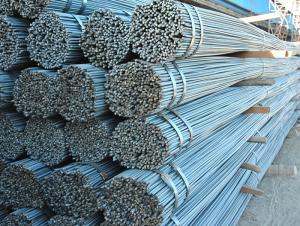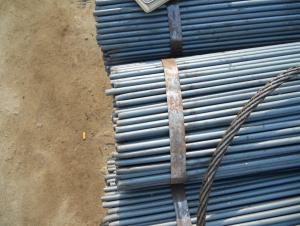Steel Round Bars Reliable Manufacturer from China
- Loading Port:
- Tianjin
- Payment Terms:
- TT OR LC
- Min Order Qty:
- 400 m.t.
- Supply Capability:
- 4555553 m.t./month
OKorder Service Pledge
OKorder Financial Service
You Might Also Like
Description of steel round bar:
1. Commodity: Round steel bar
3. Technical: Hot rolling
2. Length: Min. 5.8meter, according to requirement.
Festures of steel round bar:
1.Dia 80-800mm Length:2000-13000mm or as required
2.Technique:Forged
Specifications of steel round bar:
1. Standards: AISI 4340 8620 8640 4320 , JIS SNCM8 GB:40CrNiMoA
2. Specification: Dia: 80~450mm Length:2000-13000mm or as required
3. Process: EAF+LF+VD ( necessary) UT+ Peeled +Turned + Heat Treatment (optional). It is used in the manufacture of a higher strength and higher quenching and tempering section of the 35CrMo steel, like big locomotive traction gears, supercharger drive gear, rear axle, the connecting rod and the spring load greatly clip,it can also be used for 2000m following oil well drill pipe joints and fishing tools,and can be used for bending machine dies, etc.
4. Chemical Composition (%):
C | Si | Mn | S | P | Cr | Ni | Cu | Mo |
0.37-0.44 | 0.17-0.37 | 0.40-0.80 | 0.025(max) | 0.025(max) | 0.60-0.90 | 1.25-1.65 | 0.025(max) | 0.15-0.25 |
Images of steel round bar:
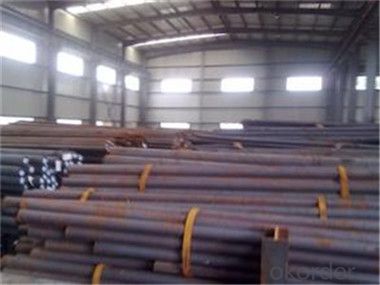
FAQ:
1. What is your package?
Packing situation: standard seaworthy packing or as customer required.
2. How long is the lead time?
Delivery time: 45 days after order confirmed.
- Q: Can steel round bars be used for making stabilizer bars?
- Yes, steel round bars can be used for making stabilizer bars. Steel is a commonly used material in the automotive industry due to its high strength, durability, and resistance to deformation. Stabilizer bars, also known as sway bars, are components in a vehicle's suspension system that help to reduce body roll and improve stability during cornering. These bars are subjected to significant forces and need to be able to withstand the load. Steel round bars provide the necessary strength and stiffness required for stabilizer bars to effectively perform their function. Additionally, steel is readily available and cost-effective, making it a popular choice for manufacturing stabilizer bars in the automotive industry.
- Q: Can steel round bars be used in the manufacturing of flanges?
- Yes, steel round bars can be used in the manufacturing of flanges. They are commonly used to create the flange body, providing strength and durability for various applications. The round bars are typically machined and shaped to form the desired flange design, allowing for a secure connection between pipes, valves, or other equipment in a wide range of industrial settings.
- Q: Are steel round bars resistant to fire?
- Yes, steel round bars are highly resistant to fire. Steel is a non-combustible material and has a high melting point, making it suitable for use in high-temperature environments.
- Q: What's the difference between bar and round bar?
- Bars can be either round or square or six sides.Another argument is that bars usually refer to short ones. The rounds are not cut, usually 6 meters long supply.
- Q: Can steel round bars be used for making tools?
- Yes, steel round bars can be used for making tools. Steel round bars are commonly used in tool making due to their strength, durability, and versatility. The high tensile strength of steel makes it suitable for withstanding heavy use and providing stability to tools. Additionally, steel round bars can be easily machined and shaped into various tool designs, allowing for the creation of different types of tools such as wrenches, chisels, punches, and hammers. Moreover, steel's resistance to corrosion ensures that tools made from steel round bars will have a longer lifespan. Overall, steel round bars are a popular choice in tool making due to their excellent mechanical properties and suitability for various applications.
- Q: What are the advantages of using nickel-chromium-cobalt alloy steel round bars?
- There are several advantages of using nickel-chromium-cobalt alloy steel round bars. Firstly, this type of alloy steel has excellent corrosion resistance properties. It can withstand extreme environments, such as high temperatures, humidity, and exposure to chemicals, without succumbing to rust or corrosion. This makes it ideal for applications in industries like aerospace, marine, and chemical processing, where durability and longevity are crucial. Secondly, nickel-chromium-cobalt alloy steel round bars possess exceptional strength and toughness. They have a high tensile strength and can withstand heavy loads and impacts without deforming or breaking. This makes them suitable for applications that require structural integrity and resistance to deformation, such as in the construction industry or in manufacturing heavy machinery. Moreover, this alloy steel exhibits excellent heat resistance. It can withstand elevated temperatures without losing its mechanical properties, making it ideal for applications that involve high-temperature environments, such as in power generation, oil and gas exploration, or furnace components. Additionally, nickel-chromium-cobalt alloy steel round bars offer good wear resistance. They can withstand abrasive conditions, such as friction and wear, without experiencing significant deterioration. This makes them suitable for applications like tooling, machining, and wear components, where durability and resistance to wear are critical. Lastly, nickel-chromium-cobalt alloy steel round bars are highly versatile. They can be easily machined, welded, and formed into various shapes, making them adaptable to a wide range of applications. Their versatility allows for customization and flexibility in design and manufacturing processes. In conclusion, the advantages of using nickel-chromium-cobalt alloy steel round bars include excellent corrosion resistance, high strength and toughness, heat resistance, good wear resistance, and versatility. These qualities make them a preferred choice for various industries, where reliability, durability, and performance are essential.
- Q: Are steel round bars suitable for bridge construction applications?
- Steel round bars are widely utilized in the construction of bridges. They possess numerous benefits for this purpose, such as their remarkable strength, durability, and versatility. These bars have the ability to withstand heavy loads and provide the essential structural support required for bridges. Furthermore, their fabrication and welding processes are easily manageable, resulting in efficient construction procedures. Incorporating steel round bars into bridge construction ensures the resistance of bridges to corrosion, a crucial aspect in environments exposed to moisture or severe weather conditions. Overall, steel round bars are an ideal and frequently employed material in bridge construction due to their strength, durability, versatility, and corrosion resistance.
- Q: What is the difference between a polished and a hot rolled steel round bar?
- The main difference between a polished and a hot rolled steel round bar lies in their manufacturing processes and the resulting surface finish. Hot rolled steel round bars are produced by heating a steel billet or ingot to high temperatures and then rolling it into the desired shape, typically a round bar. This process results in a rough and uneven surface finish with mill scale and imperfections. The hot rolled bars are generally used for applications where surface finish is not critical, such as structural components, machinery parts, and construction materials. On the other hand, polished steel round bars undergo additional processing to achieve a smooth and shiny surface finish. After the hot rolling process, the bars are processed through various grinding and polishing techniques to remove the mill scale, surface imperfections, and achieve a uniform finish. This results in a refined and aesthetically pleasing surface that is suitable for applications where appearance and visual appeal matter, such as decorative items, furniture, and architectural components. In addition to the surface finish, the mechanical properties of the two types of steel round bars can also differ. The hot rolled bars generally have a rougher surface and may exhibit some residual stresses, while the polished bars have a smoother surface and reduced internal stresses. However, the overall mechanical properties, such as strength and hardness, are primarily determined by the grade and composition of the steel used, rather than the manufacturing process or surface finish. In summary, the difference between a polished and a hot rolled steel round bar lies in their surface finish. Hot rolled bars have a rough and uneven surface with mill scale and imperfections, while polished bars undergo additional processing to achieve a smooth and shiny finish. The choice between the two depends on the specific application and the desired appearance of the final product.
- Q: What are the different types of steel round bars used in the manufacturing of shafts?
- There are several types of steel round bars used in the manufacturing of shafts, including carbon steel, alloy steel, stainless steel, and tool steel. Each type has its own unique properties and characteristics that make it suitable for specific applications. For instance, carbon steel round bars are commonly used for general-purpose shafts due to their high strength and affordability. Alloy steel round bars, on the other hand, are preferred for applications that require enhanced strength, hardness, and durability. Stainless steel round bars are used when corrosion resistance is a priority, making them ideal for shafts in industries like food processing or marine environments. Finally, tool steel round bars are chosen for their exceptional hardness, wear resistance, and ability to withstand high temperatures, making them suitable for shafts used in cutting tools or machinery. The selection of the appropriate type of steel round bar depends on the specific requirements and conditions of the shaft's application.
- Q: Can steel round bars be used for making valves or fittings?
- Yes, steel round bars can be used for making valves or fittings. Steel round bars offer excellent strength, durability, and corrosion resistance, making them suitable for various applications in the manufacturing of valves and fittings. They can be easily machined, welded, and fabricated to meet specific design requirements, ensuring reliable and long-lasting performance in valve and fitting systems.
Send your message to us
Steel Round Bars Reliable Manufacturer from China
- Loading Port:
- Tianjin
- Payment Terms:
- TT OR LC
- Min Order Qty:
- 400 m.t.
- Supply Capability:
- 4555553 m.t./month
OKorder Service Pledge
OKorder Financial Service
Similar products
Hot products
Hot Searches

